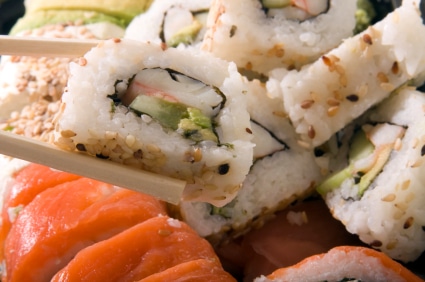
Or is it?
Made with fish, seaweed, and rice, it’s hard to believe sushi can be as unhealthy as it is healthy. While many sushi rolls are both nutritious and delicious, some “hidden” ingredients may be making your sushi rolls calorie-packed and full of fat. If you’re skeptical about what you’ve been putting in your body, here are a few tips for ordering healthy, delicious sushi.
What’s Making Your Spicy Roll Spicy?
Have you ever noticed that spicy tuna rolls are often cheaper than regular tuna rolls? The simple explanation for this is that they’re using less tuna in the spicy tuna roll, so the overall price is less. What’s being substituted for that extra tuna is a plentiful helping of a mayonnaise-based spicy sauce. This not only knocks up the calorie count, but it also adds unnecessary unhealthy fats to your sushi. Specialty rolls may use a type of oil-based spice to kick up their sushi, but most spicy rolls use some sort of mayonnaise. If you’re not sure, just ask.
Deep Fried Raw Fish?
Most people’s perception of sushi is that its raw fish, rice and seaweed, but anyone who eats sushi can tell you, that isn’t always the case. While Philadelphia rolls utilize smoked salmon which is healthy, the most common cooking method for specialty rolls is deep frying. Shrimp tempura is a popular example of a fried roll that would otherwise be a healthy option. Just like spicy mayonnaise, the fried batter added to the roll kicks up both the calorie count and saturated fats.
Mayonnaise’s Sneaky Sidekick
Just as fattening as spicy mayonnaise is cream cheese. Shouldn’t it be enough to smear it on your bagel in the morning? Many sushi rolls add cream cheese to kick up the flavor, but what it really does is kick up the fat and calorie content of your sushi rolls. You can easily substitute a salmon avocado roll if you are a Philly fan: the low calorie, unsaturated fat of the avocado is a healthy way to make up for the creaminess in any cream cheese roll without compromising flavor.
Cousin Crab
Although quite a few sushi rolls claim to contain crab meat, the dirty truth is that it’s really imitation crabmeat called surimi. Unlike the other unhealthy ingredients, this one won’t boost your fat or calorie intake, but it does contain more sodium and other artificial ingredients to make processed fish taste like crab.
Dipping Sauce Disasters
Traditionally, sushi was either eaten by itself or with soy sauce. Soy sauce can really enhance the flavors of the sushi, but it is extremely high in sodium. Opt for a low-sodium alternative; it’s often best to ask your server for one to guarantee it really is the low-sodium soy sauce.

